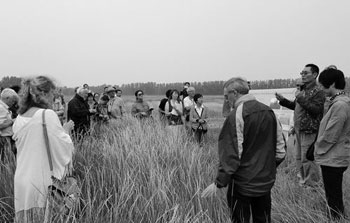Leymus chinensis, a forage crop, adapts well to adversity.
Original title: Leymus chinensis: counterattack of local feed crops

Domestic and foreign experts visited the large-scale breeding base of Leymus chinensis in Gansu.
Leymus chinensis resource garden in Beijing botanical garden. Pictures provided by Liu Commune
Change from grain to feed, grassland agriculture, herbivorous animal husbandry, grass husbandry. In recent years, the state has put the role of grass industry in the development of agricultural and rural economy in an important position. However, with the development of economy and society, especially animal husbandry, the shortage of forage grass is becoming more and more obvious. how to give full play to the role of grass industry in ensuring national food security and economic and social stability is an important issue for the field of agricultural science and technology.
Our reporter learned that the team of Liu Commune, a researcher at the Institute of Botany of the Chinese Academy of Sciences, published the first volume of Leymus chinensis Germplasm Resources Research in 2011 after more than 20 years of cumulative research, and recently published the second volume of Leymus chinensis Germplasm Resources Research. They used rich genetic information to establish the first international Leymus chinensis genome database, which laid a foundation for understanding the stress adaptation mechanism of native grasses in China, and provided new stress-resistant gene resources for wheat, corn and other crops.
What are the advantages of native plant Leymus chinensis? What is the level of Leymus chinensis research in China? What problems should be paid attention to in the process of industrialization in the future? With the above questions, the reporter interviewed people in the industry, including the team of Liu Commune.
Domestication of native plants
"the construction of the ecological Great Wall in northern China and the development of herbivorous animal husbandry is one of the important ways to solve the source of food in our country, and the biggest problem in the development of herbivorous animal husbandry in the north is the lack of feed."
This strategic idea of Li Zhensheng, academician of the Chinese Academy of Sciences at that time, led Liu Gongshe to shift his research direction from sunflower to forage grass, accepted his suggestion, and selected the native plant Leymus chinensis with high yield, high quality and strong adaptability to carry out systematic research and development in terms of resources.
According to Nan Zhibiao, academician of the Chinese Academy of Engineering and professor of the School of grassland Agricultural Science and Technology of Lanzhou University, the domestication, breeding and utilization of native plants has always been an important part of scientific research and production practice. "in a sense, the history of agricultural development is also a history of understanding, domestication, breeding and utilization of wild animals and plants."
In recent years, sustainable development has become the theme of the times, and how to give full play to and make full use of the advantages of native plants is a field that scientists all over the world pay close attention to and actively study.
For this reason, the United States has established the publication Native plants, which comprehensively reflects the achievements and developments in this field.
According to Nanzhibiao, the work carried out by various countries is mainly focused on two aspects: one is to domesticate wild native plants with excellent characteristics into cultivated varieties, which directly serve the production of agriculture and animal husbandry. For example, New Zealand scientists used wild plantain containing tannin to domesticate it into a cultivated variety, as a part of ryegrass white clover mixed grassland, to overcome the swelling disease of grazing livestock.
"on the other hand, scientists from all over the world have made good progress in tapping the excellent genetic resources of native plants to improve forage or crop varieties." Nan Zhibiao said.
According to the data of the first national grassland census, there are more than 6700 species of forage plants. Among the forage varieties bred in China, about 1/3 of them are domesticated and bred.
From the academic point of view, Leymus chinensis is one of the most excellent native grass species in China, and it is widely distributed in the north of China.
High quality characteristics of Leymus chinensis
"Leymus chinensis is a representative native species in the grasslands of northern China, and Leymus chinensis grassland is an excellent natural grazing and mowing grassland, which plays an important role in the development of animal husbandry and ecological environment protection in the north." Liu commune told our reporter.
The characteristics of Leymus chinensis, such as wide adaptability, strong stress resistance, high yield and good feeding value, have long been highly concerned by the scientific and technological circles and industry.
In the 1950s, scholars from Northeast normal University, Inner Mongolia University and the Comprehensive examination Society of the Chinese Academy of Sciences carried out continuous research on Leymus chinensis and Leymus chinensis grassland. Since the 1980s, scholars from Inner Mongolia Agricultural University, Institute of grassland of Chinese Academy of Agricultural Sciences and Institute of Biology of Jilin Province have domesticated, selected and approved six varieties through the National Grass Variety approval Committee.
As a key species of grassland in northern China, Leymus chinensis has indeed received continuous attention from academic circles. "however, its perennial habits, low fruiting and large and complex genome make the research work difficult and slow." Liu commune said.
The reporter learned in the interview that after more than 20 years of exploration, the team of Liu Commune has established a practical and efficient technical route for exploring Leymus chinensis germplasm resources. that is, germplasm resources collection-phenotypic research-genome analysis-germplasm innovation-new variety cultivation. On this basis, more than 1000 Leymus chinensis germplasm resources at home and abroad have been collected, and new Leymus chinensis varieties "Zhongke 1", "Zhongke 2" and "Zhongke 3" with high yield, high quality and stress resistance have been cultivated.
It is understood that the United States, Japan, South Korea, the Netherlands, Russia, Mongolia and other countries also pay close attention to the ecology of Leymus chinensis and the development and utilization of germplasm resources in Eurasia, "but their research is relatively scattered, with only some academic papers and investigation reports. There are no monographs on systematic research and development of Leymus chinensis germplasm resources." Liu commune said.
In October this year, Liu Commune team officially published the second volume of Leymus chinensis Germplasm Resources Research. The publication of the book has also attracted the attention of the industry. Nan Zhibiao commented: "this book represents the current research level of important native grass species Leymus chinensis at home and abroad, and is of great value in the research of plant genetic resources, prataculture science, animal husbandry and ecology." it is of reference significance for the development and utilization of forage grass and native grass species at home and abroad. "
Industrialization depends on technical support
After getting the book, the reporter found that compared with the first volume, the second volume added some industrialization elements. for example, the last five chapters focus on the resistance of Leymus chinensis to herbicides, response to water, water and fertilizer demand characteristics, sexual reproduction and fertilization on seed production.
In fact, China is a big country of grassland resources in the world. However, the reporter learned in the interview that the domestic demand for natural forage has been in a tense state, and the momentum of grazing grass in large-scale pastures and pastoral areas is becoming more and more obvious. Compared with the developed countries of grassland animal husbandry, the production level of animal products per unit area is only equivalent to that of New Zealand, America and Australia.
In the view of Nanzhibiao, making full use of and giving full play to the advantages of rich grassland plant diversity, improving degraded farmland and grassland is not only an important task for Chinese scientific and technological workers, but also a quick way to control degraded land resources.
In 2012, the central government launched the "Revitalization of Dairy Alfalfa Development Action", with 3000 mu as a unit for support, and 500000 mu in the first year. In this year, more than 130 enterprises entered the industry, some of which have production experience and production experience.
In 2012, the total area of forage seed fields was 1.786 million mu, and 7500 mu of seed fields were added in 2013. In 2014, the relevant national seed engineering projects further supported the development of forage seed production, and the area of forage seed production in China continued to increase. "however, it is still difficult to meet the market demand, mainly due to low forage seed yield and low efficiency of seed production, which is still one of the main factors restricting the development of forage industry." Zhang Yingjun, chief scientist of the national forage industry technology system and professor of the School of Animal Science and Technology of China Agricultural University, once introduced it to our reporter.
Related
- A course of planting techniques and methods on how to grow carrots
- How to plant the latest tulips?
- Is it better to pick tea in the morning or in the afternoon? When is the best time for tea to be picked? what is the third or fifth tea?
- Launch Yuanxiao Happy combination Haocha + Tea Yuan healthy Taste
- Penghu Tourism "Fireworks 20 Parade with You"
- 2022 West Lake Happiness holds "Digital Revitalization Voucher" and draws iphone13 and laptop.
- Banqiao Fuzhou social houses are designed to change start-up combined with police elimination to create a safe and livable environment
- The convenient measure of "mechanical weeding" in Xinbei has been abused and the Agriculture Bureau has imposed heavy penalties on the illegal land consolidation.
- Changgeng University Joins Hands with Four Memory Factories to Rescue Memory Talent Shortage
- The list of Taiwan's top 100 MVP managers is listed by the Director-General of the Farmers' Association of Sanxia District.



